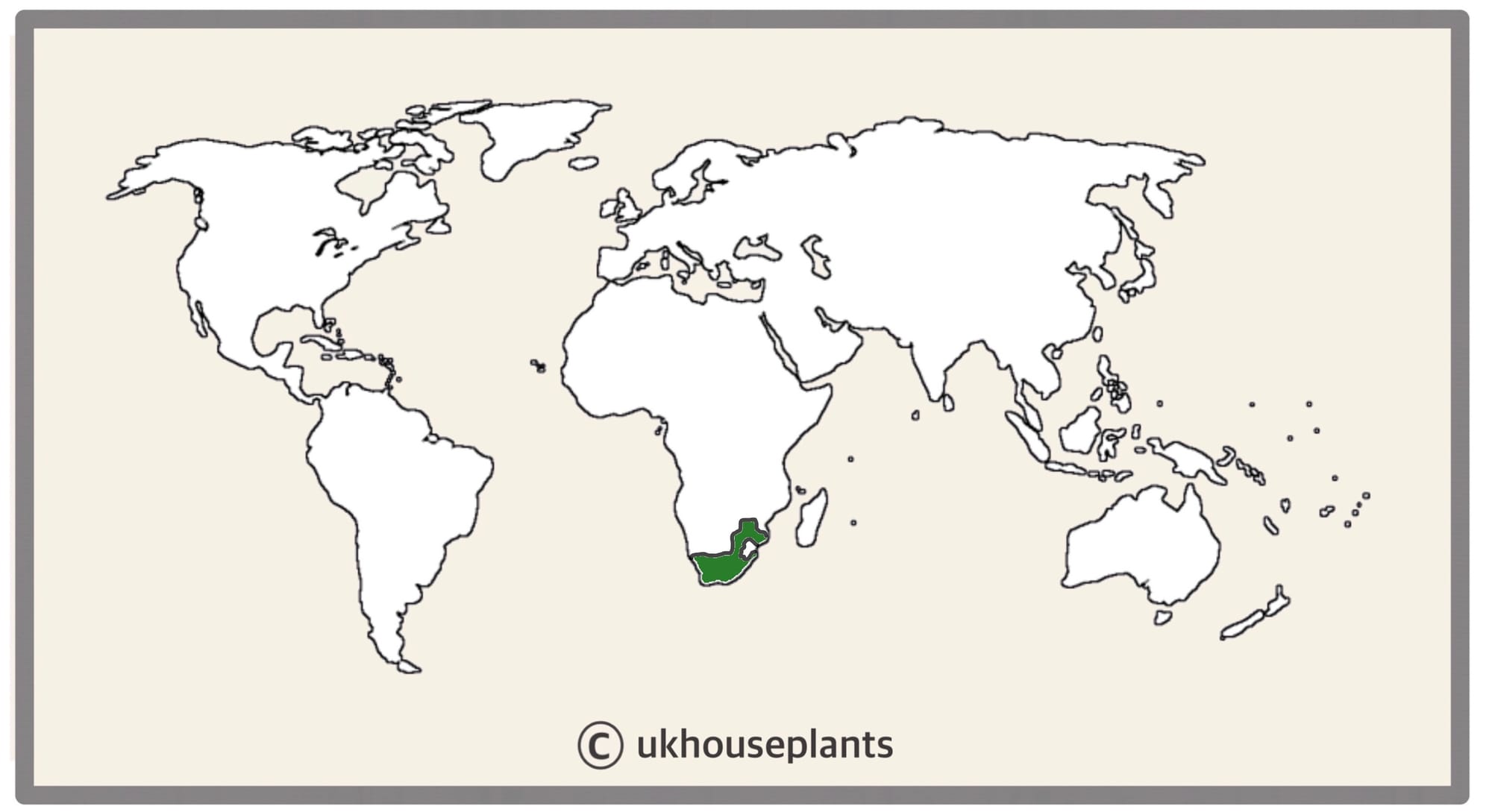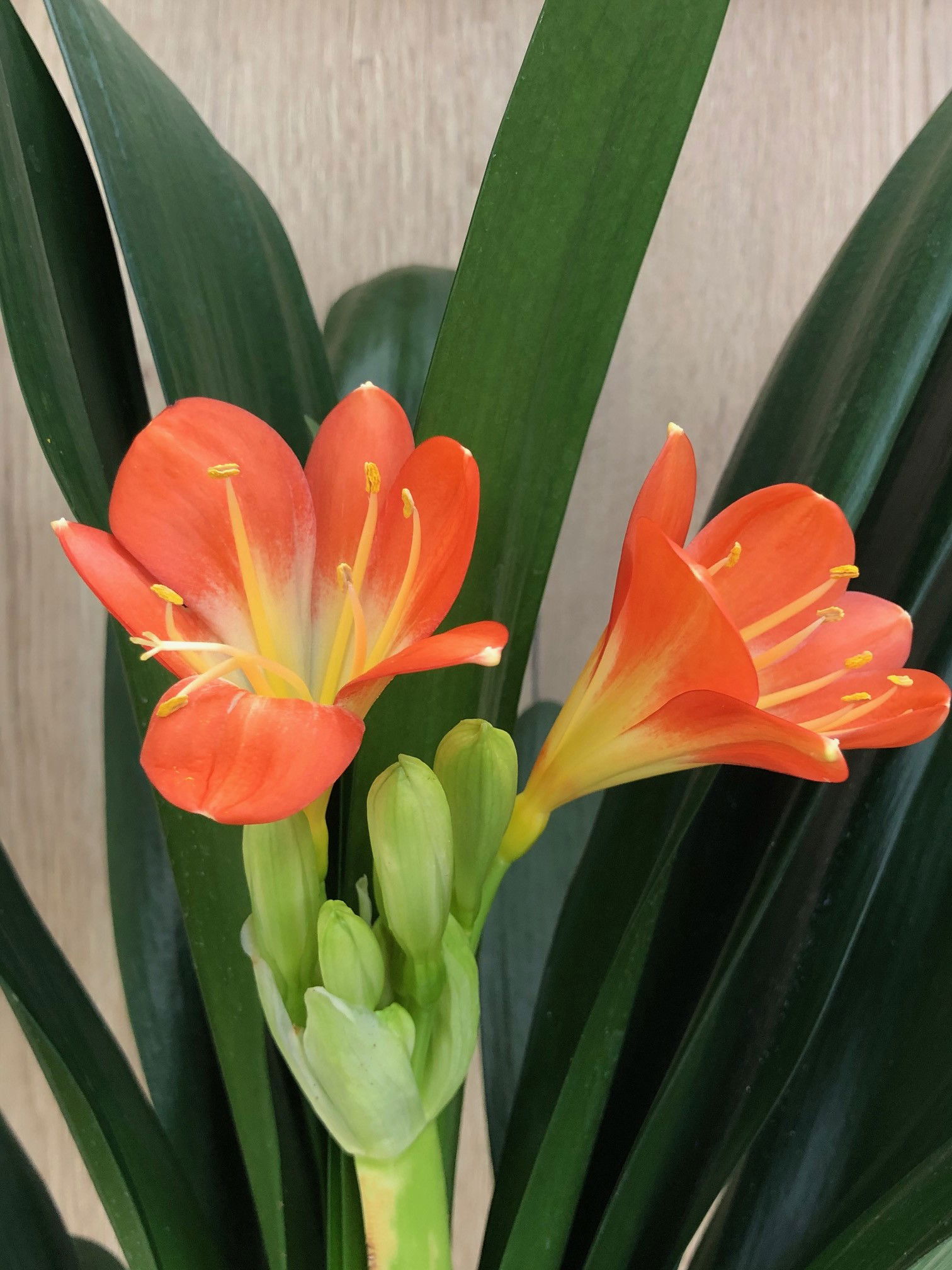
Clivia miniata 'Forest Flame'
Contents
- Top Tips
- Location, Water, Humidity & Fertilisation
- Dormancy Care & Annual Flowers
- Common Issues
- Origins, Temperature, Propagation, Repotting & Toxicity.
Need the answer to a specific plant query? Book a 1-to-1 video call with THE HOUSEPLANT DOCTOR™, the website's friendly author, to overcome and address your niggling problem! Available on iMessage, WhatsApp, Facebook Messenger & more.
Top Tips & Info
- Care Difficulty - Very Easy
- Clivia are excellent at growing in almost all light levels in your home. For optimal growth (& higher chances of yearly blooms in late spring), provide a bright windowsill with up to an hour or two of morning sunlight.
- Under-watering is always better than over-doing it with Clivia. Allow the top half of the soil to dry out in between waters, reducing this further in the autumn and winter. If in doubt, leave your plant for another few days before watering again.
- All year round, fertilise every fourth water using a 'Houseplant' labelled feed. While in bloom, you can use something that's high in potassium - 'Tomato' food is an excellent choice.
- Repot your specimen every few years in a pot with drainage holes in its base. A 'Houseplant' labelled potting mix is best for this plant, as too water-retentive soil may result in root rot.
- Noticed rotten roots in your Clivia's soil when repotting? This is common behaviour and part of the plant's maturity so don't worry. Prune the dead, collapsed roots and repot in the same sized pot with 'Houseplant' potting mix - new roots will re-emerge in due course. Scroll down to 'Repotting' for more information.
- Dust the leaves regularly to avoid a build-up of dirt. This will not only increase the light-capturing efficiency, but it'll also benefit its overall health with better-stored energy for leaf and flower growth in the future.
Location & Light - 🔸🔸
A location with a splash of morning or evening sun is the ideal area for this species, as too dark settings will heighten the chance of root rot. If you're worried about its location being too dim, if a newspaper can be read whilst having your back towards the light source, you're good to go. Although the sunlight can be quite beneficial for a Clivia, avoid scorching the leaves with too intense rays - typical signs are murky yellow foliage and brown spots developing on the top side of the leaf.
In terms of the ideal location room, a north, east or west-facing window, or a semi-shaded conservatory are excellent areas for optimum growth.
Water - 🔸
Allow the top half of the soil to dry out in between irrigations. Once the pot feels light when lifted compared to when it was last watered, it's time for another hydration. It's always better to under-water a Clivia than over-do it, as they naturally grow in firm forests around southern Africa that can pursue short-lived droughts. Increasing the chance of a bloom in the spring can be achieved by decreasing the number of waters in the autumn and winter for its dormancy period. Never apply cold water to the roots, especially when it's in flower, due to the tendency to drop lose in some instances. Under-watering symptoms include curled or crispy leaves, wilted foliage, yellowing leaves and stunted growth. These issues are commonly caused by too much heat or sunlight, or pure forgetfulness. Over-watering symptoms include the yellowing or browning of lower leaves, stunted growth, wilting and a rotten core. Like Moth Orchids, water-logging is a common and serious issue among growers. Because of the compost's well-draining nature, excess moisture will flow through the potting mix and congregate in the bottom, causing root rot if left. Over-watering is commonly caused by too little light or heat or a lack of drying soil in between irrigations. If this has happened to yours, scroll down to 'Common Issues' for more information.
Humidity - 🔸
Average room humidity is more than enough to occupy a Clivia, as too high humidity and poor air circulation may result in grey mould forming in the base's cubbyholes. Never mist the flowers to increase humidity as botrytis petal blight will develop.
Fertilisation - 🔸🔸
Use a fertiliser high in potassium to prolong its flowers during the blooming period - an excellent example would be a 'Tomato' feed. Regular fertilisers, for instance, BabyBio or Miracle-Gro, will still do the job but will favour foliar growth as well as the flowers. For the rest of the year, a standard fertiliser can be used as a monthly supplement to aid foliar and root growth.
Dormancy Care & Annual Blooms
At ukhouseplants, we regard Clivia as the Amaryllis' "evergreen cousin" as it won't lose its foliage over the colder months. It's also much easier to grow and achieve flowers than the latter, so if you're still new to horticulture but want something that's a little different - Clivia are the ones for you!
In order to accomplish yearly flowers in the springtime, a good dormancy in the autumn and winter is needed. The tips below should be started from autumn until early spring when the plant's growth rate is at its slowest.
Droughts, Droughts, Droughts!
It's all about under-watering with Clivia. Only rehydrate the soil once the majority has fully dried out and never promote water-logging to avoid root rot. Present a bright, partially sun-filled location with little fertilisation during this period to put pressure on the plant. Dust its foliage to increase the light-capturing efficiency, which in turn will help with its overall well-being and health.
Potbound Roots
Like the Moth Orchid or Anthurium, the Clivia's roots must be pot bound to aid the chance of another bloom. They must feel restricted to send out a flower stalk for reproduction and to pass on its genes. Now, of course, there are other factors such as the temperature and daylight hours which can help this process, but starting with its roots is always a great idea. A bonus of keeping the plant pot bound is that you're far less likely to over-water the specimen, due to the ratio of soil to roots, which greatly favours the latter.
Temperature
Many houseplants cannot serve a good dormancy over the winter when the temperatures are more or less consistent throughout the year. Situating a Clivia in a cooler location during this time will empathise its inaction, thus focusing its energy on producing the flowers later on. Once spring is around the corner, keep the plant in the cooler setting until flower buds form at the base. Once this development is underway, supplement the plant with a fertiliser high in potassium fortnightly to elongate the flower's life - 'Tomato' food is best. Swap to a monthly 'Houseplant' fertiliser once the blooms have elapsed.
Common Issues with Clivia
Over-watering is the biggest issue with Clivia. Although moist soil is vital for long-lasting flowers, avoid keeping the soil saturated for extended periods to prevent the chance of rot. Allow the top third of the soil to become dry in between irrigations and always use tepid water to avert shocking the tender root systems. Typical signs of over-watering include yellowed leaves, stunted growth and a rotten base. If the base has fully softened over, this will spell the end of its life. For those who want to save it, remove the plant from the pot to investigate its root health - discard the affected roots using a clean pair of scissors, along with most of the sodden soil. If there aren't many roots remaining, repot it into a smaller pot, just enough to accommodate the stem. Do not discard the 'bulb' if no roots are present, keep it in a fresh batch of compost and water irregularly - it will re-root itself within the next few months.
Small flies hovering around your plant is entirely natural and may just indicate you're watering a little too often. Fungus Gnats are a common 'pest' with Clivia, but won't pose any risk to the plant's health. Simply replace the top third of the plant's potting mix for a fresh batch of 'Houseplant' labelled compost, typical found at most garden centres. Remember to reduce the frequency of watering to avoid this happening again!
Too much sunlight will lead to sun-scorch, with typical signs including brown patches, a murky yellow appearance, crispy or curled leaves, dry leaf-edges or little growth. Although low light will cause over-watering issues, too much sunlight will also be a detriment in the likes of dehydration. A location that offers a little to no direct light will bring the optimum growth for a Clivia, as they aren't susceptible to the excessive sun in their natural environment of South Africa.
Too little light will cause the wilting of leaves and a pale centre but without a softened base. If this has occurred with your specimen, improve the amount of light fractionally, keeping in mind the heightened chance of environmental shock (when two locations offer too different growing conditions) and sun-scorch.
A lack of flowers is caused by an insufficient dormancy period, served in the winter months. Locations that offer near-similar temperatures all year round won't allow the plant to go dormant, resulting in poor spring growth. To achieve, situate in a location that dips to around 10°C (51°F) with fewer waters. Allow the majority of the compost to dry out and provide a humidity tray while the radiators are operating.
Small or short flowers can be the result of a lack of dormancy over the autumn and winter period. Ensure that your Clivia isn't watered too often during the months of October to March. During this period, THE HOUSEPLANT DOCTOR™ recommends rehydrating the soil once it fully dries out for around a week, while only fertilising it every fourth water. From the start of April onwards, increase the frequency of watering slightly and mix-in a 'tomato' labelled fertiliser every third water to increase the size of its future blooms.
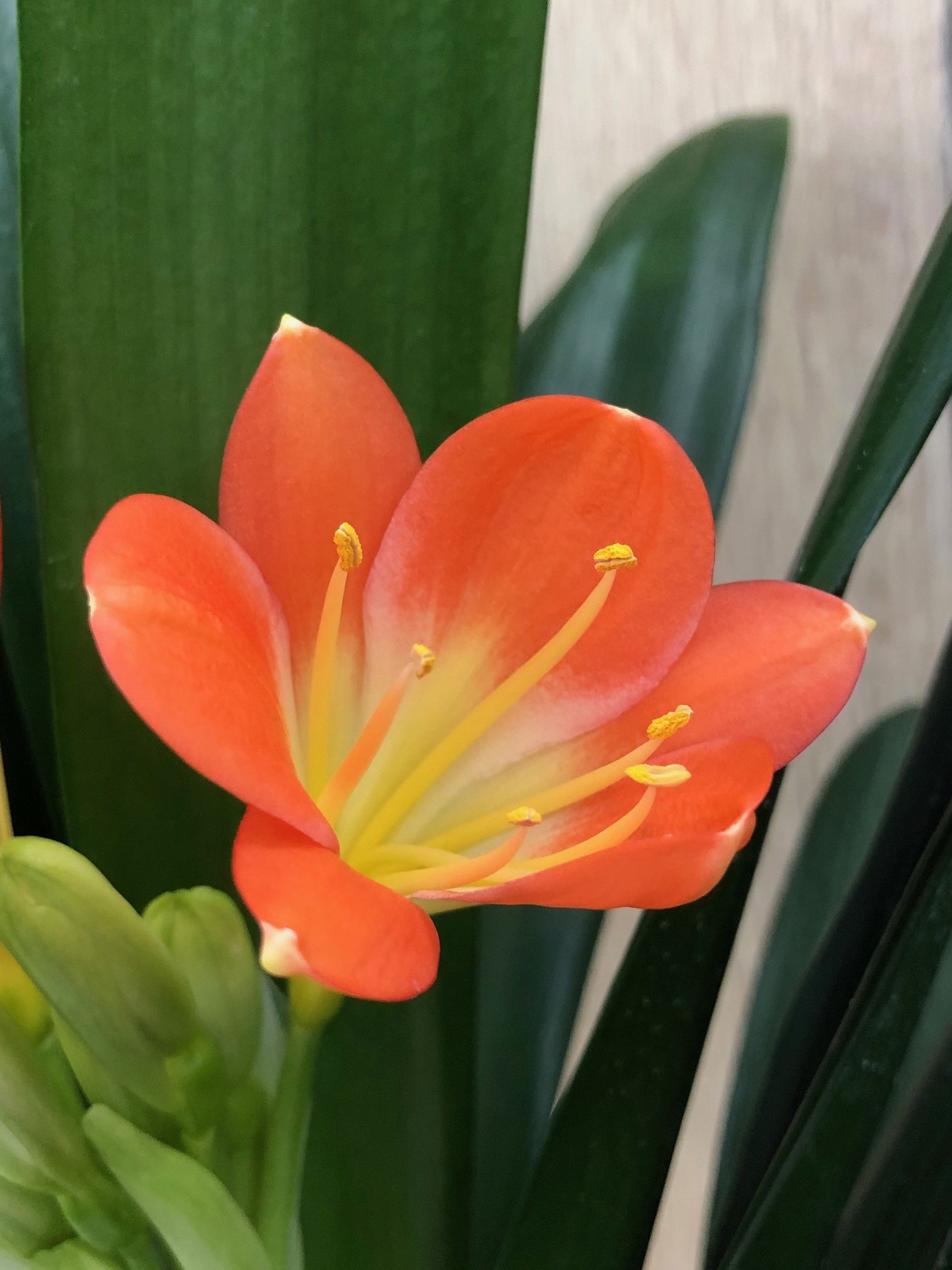 The beautiful inflorescence of a Clivia miniata.
The beautiful inflorescence of a Clivia miniata.
Origins
There are six recognised species within Clivia, all originating from Southern Africa. Live specimens were taken to England in the late 1810s by British explorers John Bowie and William Burchell. The C. nobilis was the first species to be named in the Clivia genus, which is named in honour of the Duchess of Northumberland, Charlotte Percy (née Clive). This genus is the cousin to the true Amaryllis, due to its similar leaf and flower structures. The most popular species of Clivia, C. miniata, can be translated from Latin to mean 'Cinnabar-red', which refers to the flower's deep red appearance.
Temperature
6° - 25°C (43° - 78°F).
H1c (Hardiness Zone 11) - Can be grown outdoors between late spring and summer throughout most of the UK while nighttime temperatures are above 8℃ (46℉). If you decide to bring the plant outdoors, don't allow it to endure more than an hour of direct sunlight a day as it may result in sun-scorch. Regularly keep an eye out for pests, especially when re-introducing back indoors.
Spread
Up to 1m in height and width. The ultimate height will take between 6 - 10 years to achieve when repotted biannually.
Pruning
Remove yellow or dying leaves, and plant debris to encourage better-growing conditions. While pruning, always use clean utensils or shears to reduce the chance of bacterial and fungal diseases. Never cut through yellowed tissue as this may cause further damage in the likes of diseases or bacterial infections. Remember to make clean incisions as too-damaged wounds may shock the plant, causing weakened growth and a decline in health.
Once the blooms have finished, the flower stalk can be removed with a clean pair of scissors without harming the base, unless there's a development of swelling seedpods. Never cut the foliage back to its base.
Propagation
Via Seed or Basal Offset Division.
Basal Offset Division (Pups) (Easy, Photo Below) - For this method, it's best to divide in spring or summer and once the offshoots are at least a third of the mother plant's size, with several well-established leaves. Remove its pot and place your hand in between the junction that connects the two; soil may have to be brushed away to get a better grip. Gently push the pup downwards while supporting the mother plant until you hear a snap. Cautiously separate the root systems, keeping great care in keeping them damage-free. Place the new plantlet in a small pot with a 'Cactus & Succulent' labelled potting mix, much similar to the original soil, and maintain the same care routines. Provide a bright setting with temperatures around 18°C (64°F) with the majority of the soil drying out in between waters. New leaves should emerge within the six weeks, as long as the soil is kept on the drier to life.
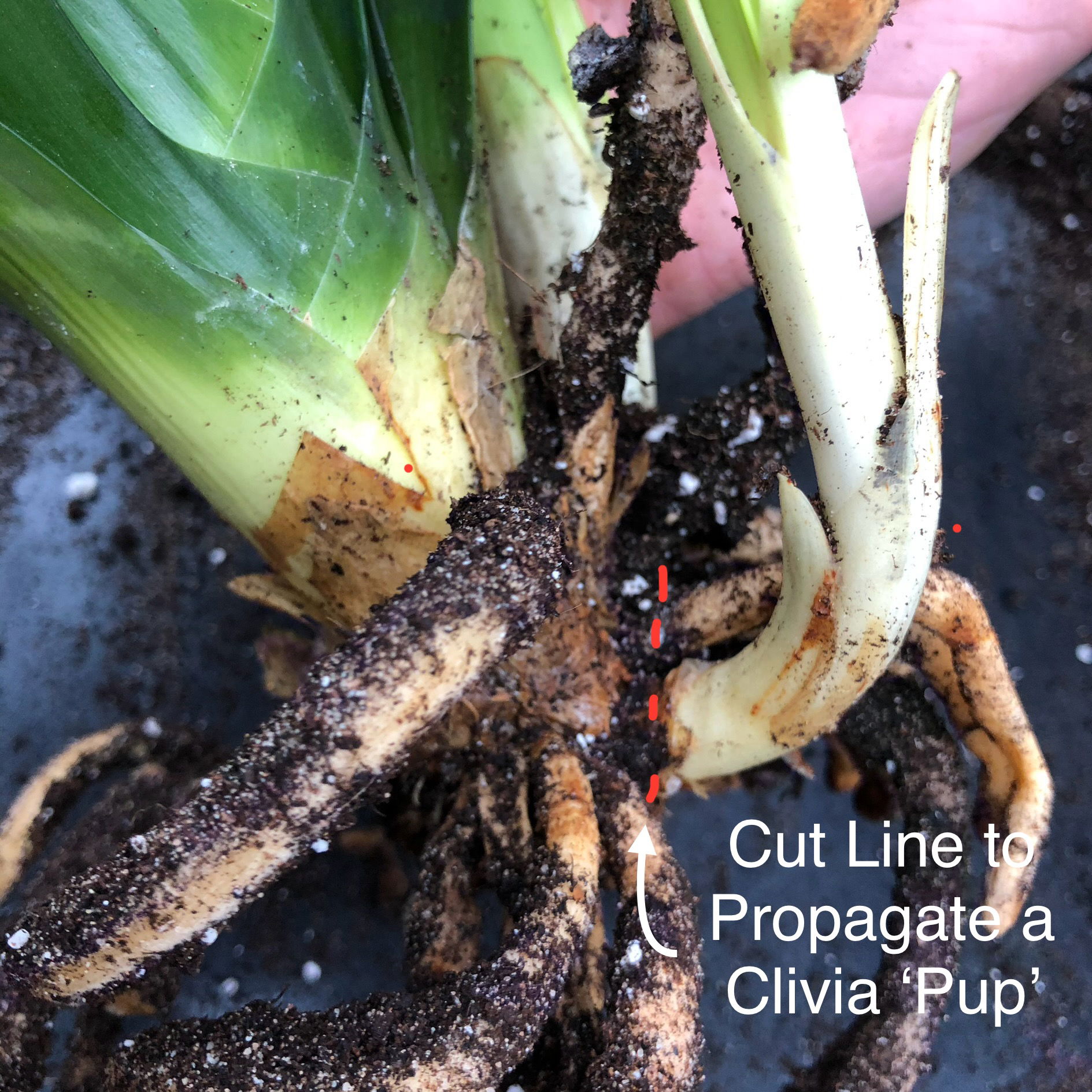 Offsets (or 'Pups') can be separated once the reach around a third of the mother plant's size. The red dotted line shows where to prune for propagation.
Offsets (or 'Pups') can be separated once the reach around a third of the mother plant's size. The red dotted line shows where to prune for propagation.
Flowers
Their flowers are relatively large, trumpet-shaped flowers that are arranged in threes or fours at the top of one or two shafts, usually around 30cm in height. The individual flower lasts up to ten days, with the overall show spanning two months - typical colours are white, yellow and orange. Most specimens will bloom within the region of September and March but can flower at any given time.
If you'd like to get your specimen to bloom in time for the festive period, scroll up to the section labelled 'Dormancy Care & Annual Flowers' for more information!
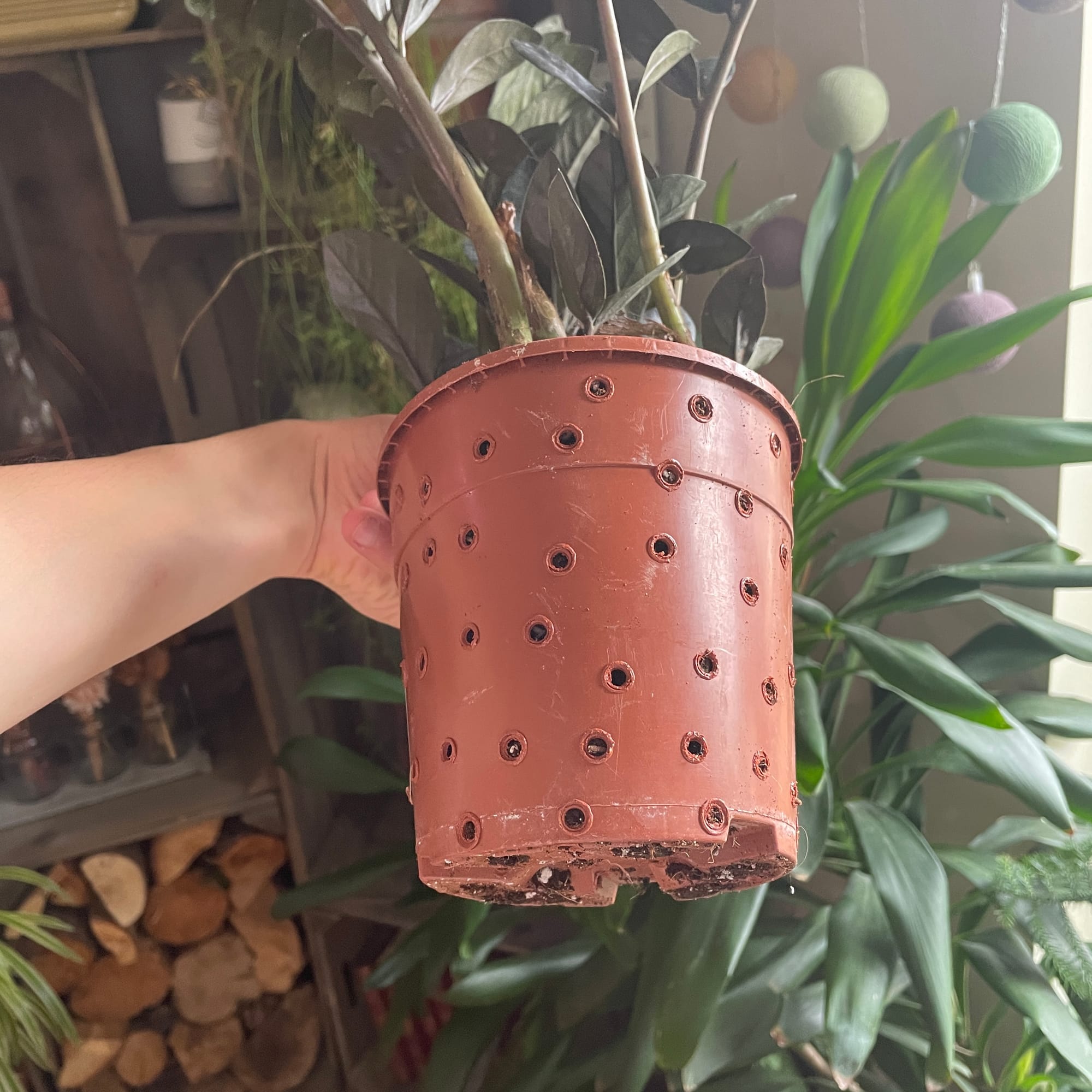 Similarly to the ZZ Plant (pictured), your Clivia will benefit from having a few holes in its plastic pot to reduce the risk of root rot. We recommend using a Soldering Iron.
Similarly to the ZZ Plant (pictured), your Clivia will benefit from having a few holes in its plastic pot to reduce the risk of root rot. We recommend using a Soldering Iron.
Repotting
Repotting Clivia plants is slightly different to other houseplants due to the root system 'shedding' its older roots when new ones are emerging (usually in late winter). This means that when you come to repot it, up to 50% of the root system might have become deflated/flat/rotten. Don't panic - simply prune off the dead roots with a clean pair of scissors, while keeping any healthy plump roots on the plant.
The best time to repot is in late spring or early summer, after any flowers that may emerge over that period. Use a 'Cactus & Succulent' labelled soil mix as your potting medium. The size of pot will depend on the size of your Clivia's root system - scroll to the next two sections to learn more.
Repotting a Healthy Rootball (Less than 50% of the roots have died/become dehydrated)
1. When it's time to repot, hold the plant's base and gently shake the rootball a few times - discard all soil that falls off.
2. Check the health of the roots. Dead roots are often the same colour as healthy ones, albeit deflated/flat and can easily be pulled from the plant's base. If only 20% or less of the rootball has died, repot the Clivia into the next sized pot with potting mix after pruning off the dead roots. Keep the healthy, plump roots attached to the plant. See image below for a healthy Clivia root system.
3. Fill the pot's bottom quarter with 'Cactus' labelled potting mix and rest the rootball on top. Fill the remaining gaps until the plant is comfortable in the mix and water 24hrs after to allow the roots to rest. Give the pot a few taps on the side to shift the soil into place.
4. Ensure you don't 'pat', push-down or compact the soil down using your fingers as this will reduce oxygenation and air circulation in the soil. The potting mix will naturally compact with each time it's watered.
5. Water your plant less often as you did before repotting for at least six months to allow the roots to grow into the potting mix.
Repotting a Rootball Where More Than 50% Has Died/become dehydrated
1. When it's time to repot, hold the stem's base and gently shake the rootball a few times - discard any soil that's released for the garden or bin.
2. Check the health of the roots. Dead roots are often the same colour as healthy ones, albeit deflated/flat and can easily be pulled from the plant's base. Keep the healthy, plump roots attached to the plant. See image below for a healthy Clivia root system.
3. The next steps are only suitable for Clivia where more than 20% of the roots have rotten. If this is the case, prune away the affected roots with a clean pair of scissors and repot back into the same pot.
4. Fill the pot's bottom quarter with 'Cactus' labelled potting mix and rest the rootball on top. Fill the remaining gaps until the plant is comfortable in the mix and water 24hrs after to allow the roots to rest. Give the pot a few taps on the side to shift the soil into place. Ensure you don't 'pat', push-down or compact the soil down using your fingers as this will reduce oxygenation and air circulation in the soil. The potting mix will naturally compact with each time it's watered.
5. Water your plant less often as you did before repotting for at least six months to allow the roots to grow into the potting mix.
Book a 1-to-1 video call with THE HOUSEPLANT DOCTOR™ if you'd like a personal guide to repotting your houseplant. This will include recommending the right branded-compost and pot size, followed by a live video call whilst you transplant the specimen for step-by-step guidance and answer any further questions!
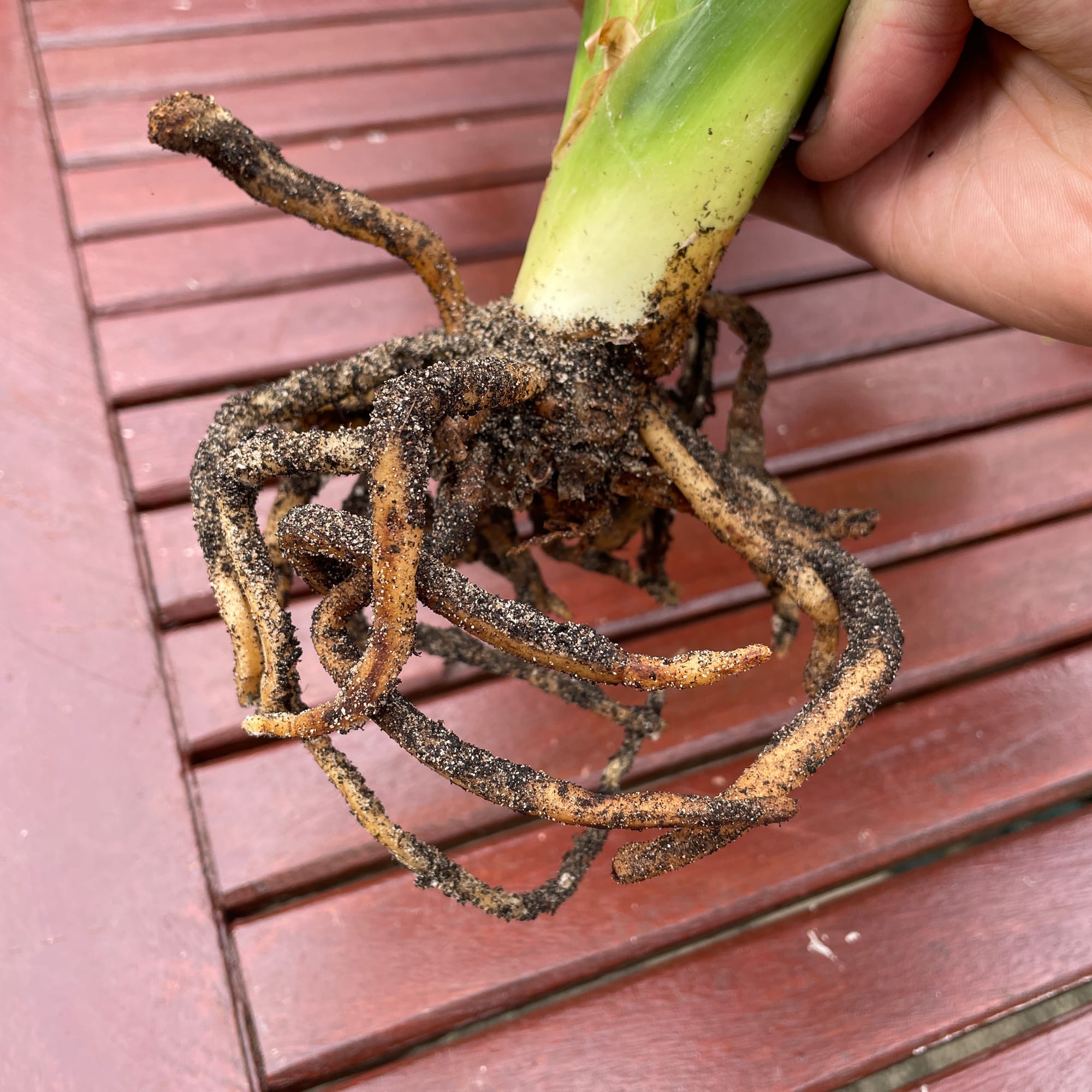 Here's a healthy Clivia root system.
Here's a healthy Clivia root system.
Pests & Diseases
Keep an eye out for thrips, aphids, mealybugs and snails / slugs. Common diseases with Clivia are bulb or root rot, powdery mildew, leaf-spot disease and botrytis petal blight. Most diseases are caused by excess moisture in the soil or on the flowers or foliage; maintain dry leaves and always avoid water-logging for best results. For more info on how to address any of these issues, click on this link - Identifying Common Houseplant Viruses & Diseases.
Toxicity
This plant is classified as poisonous. If parts of the plants are eaten, vomiting, nausea and a loss of appetite could occur. Consumption of large quantities must be dealt with quickly; acquire medical assistance for further information.
Retail Locations
Specimens are likely to be found in some garden centres during the spring or summer.
Book a 1-to-1 Call with THE HOUSEPLANT DOCTOR™
If you need further advice with your houseplants, book an advice call with ukhouseplants' friendly and expert writer today! This can be done via a video or audio call on most apps, including Facebook, FaceTime & Skype. A ten-minute call costs £5.99 (US$7), or £15.99 for thirty minutes. You can ask multiple questions, including queries on plants, pests, terrariums, repotting advice and anything in between. Please consider supporting this service to keep ukhouseplants thriving!
